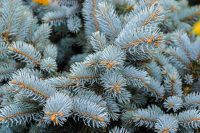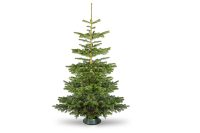Norway spruce (Picea abies) is non-toxic to dogs, and is safe to keep as a Christmas tree or ornamental plant in the garden. However, precautions must be taken to keep dogs (and cats) safe.
What is Norway spruce?
| Family | Pinaceae |
| Botanical name | Picea abies |
| Common names | Common spruce, European spruce, Christmas tree |
| Mature height | 15 – 22 metres (50-75 feet) |
| Needle retention | Prone to needle loss |
| Scent | Pine and citrus |
| Native to | Europe |
| Toxicity | Non-toxic |
The fastest-growing of all the Christmas trees, Norway spruce (Picea abies) is a large, coniferous tree native to Eurasia. Norway spruce is loved for its beautiful pine scent, layered branches and shapely form and is widely cultivated in North America to cater to the Christmas tree market. The wood is also used in the paper, construction and lumber industries.
The conical shape and upward-slanting branches make Norway Spruce one of the most popular Christmas trees. Each year, a Norwegian Spruce is felled outside Oslo and gifted to the cities of London, Edinburgh and Washington DC as thanks for the aid each country provided during WWII.
Related: Caring for a Christmas tree
What should I do if my dog chews Norway spruce?
Carefully remove any remaining plant matter from the dog’s mouth if it is safe to do so and offer a drink of something tasty such as milk. Ingestion of a few needles is not a serious risk, however, large ingestions of pine needles have the potential to cause issues. If your dog has consumed any part of Norway spruce, keep a close eye on the dog and if symptoms such as drooling or vomiting develop, seek veterinary attention.
When to see a veterinarian
Seek veterinary attention if the dog develops clinical signs such as loss of appetite, drooling or vomiting. While Norway spruce is non-toxic, large ingestions of pine needles can damage the gastrointestinal tract.
Safety

While Norway spruce is non-toxic to dogs, there are still some risks with Christmas trees and pets.
- Take care with tree preservers or fertilisers in the tree water bowl, as these are both toxic to dogs.
- Place breakable decorations higher up on the tree to prevent them from being knocked down.
- Always unplug Christmas tree lights at the socket when they are not in use or there is nobody to supervise.
- Routinely sweep up fallen pine needles, which can cause GI obstruction and/or trauma.
- Hold off decorating for a few days after bringing the Christmas tree home, this can allow the dog to become familiar with the new addition before the decorations go up.
- Do not place edible decorations such as candy canes and especially chocolate on the Christmas tree. Chocolate is toxic to dogs and candy canes can cause GI upset if ingested.
- Purchase a sturdy stand for the Christmas tree and secure to a wall with fishing wire to prevent it from being knocked or pulled over.
Toxicity of common Christmas trees to dogs
Common name |
Scientific name |
Toxicity level |
| Norway spruce | Picea abies | Non-toxic |
| Blue spruce | Picea pungens | Non-toxic |
| Serbian spruce | Picea omorika | Non-toxic |
| White spruce | Picea glauca | Non-toxic |
| Nordmann fir | Abies nordmanniana | Non-toxic |
| Fraser fir | Abies fraseri | Non-toxic |
| Douglas fir | Pseudotsuga menziesii | Non-toxic |
| Noble fir | Abies procera | Non-toxic |
| Balsam fir | Abies balsamea | Non-toxic |
| Grand fir | Abies grandis | Non-toxic |
| Scotch pine | Pinus sylvestris | No information available |
| White pine | Pinus strobus | No information available |
| Virginian pine | Pinus virginiana | Toxic |
| Norfolk Island pine, house pine | Araucaria heterophylla | Non-toxic |
Julia is a writer and landscape consultant from Wollongong with a love of horticulture. She had been an avid gardener for over 30 years, collects rare variegated plants and is a home orchardist. Julia is passionate about learning and sharing her knowledge of plant propagation and plant toxicology. Whether it’s giving advice on landscape projects or sharing tips on growing, Julia enjoys helping people make their gardens flourish.




